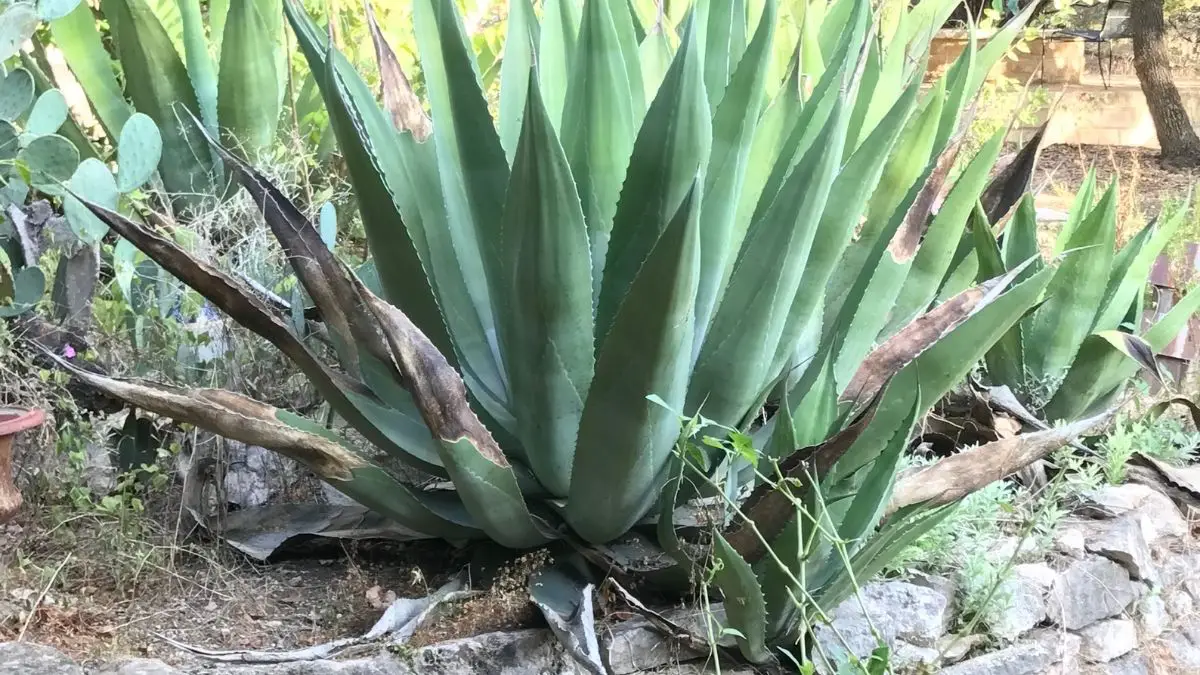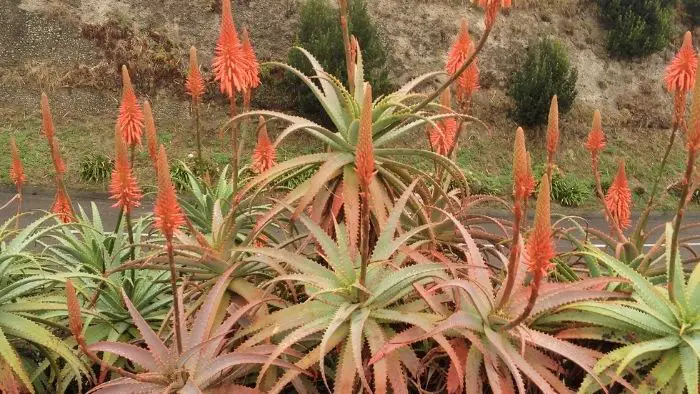Last Updated on July 6, 2022 by Marco C.
Why is my Agave plant dying? These plants are tough! There are a lot more people out there who want to know how to kill agaves, than how to stop them from dying! If you are in the very small, unique category of people on Earth who have actually managed to kill, or nearly kill an agave, this article is for you.
What Is An Agave Plant?
The agave genus is comprised of distinctive beautiful plants with rosettes of leaves. These plants are indigenous to the Americas but are not spread globally. They are typical succulent plants and take a few years (in some cases many many decades), to reach maturity. At maturity, the mother plant will send up a large flower that will set the seed. At this point, the mother plant dies and rhizomatous suckers (pups or baby plants) grow up from the base to replace her. In this case, when answering our question “Why is my Agave plant dying?” it is clear that if your plant has flowered, and set seed the main plant will die. Let it dry out, and remove it – the pups will soon replace it.
Learn more about: The Best Fertilizer for Cactus and Succulents
The plants employ CAM photosynthesis giving them great drought tolerance. In fact, these plants generally love being dry – they can be killed by too much water. They generally have rhizomes that can store water in addition to what is stored in the leaves. These plants can grow in areas that get very little rain. I had a look at a bit of what people have written on the various blogs – and there is some absolute rubbish out there! Some people say that Agave americana for instance can be killed by too much sunlight! When I was a kid I grew up in a desert – we had agave all over and these things were in direct baking hot sunlight in 104°F plus heat!!
Agave plants often contain chemicals in their juice which if you get it on your skin causes a most uncomfortable burning sensation. I discovered this once when a friend and I tried to make tequila from blue agave. We dug the plant up – to do this we had to chop off all the leaves, leaving the “nut” or heart of the plant. In the process of doing this, we got covered in the juices of the plant. It did not hurt at the time – but in the evening the pain started – it is like a slow fire that spreads over your body. We found washing the skin with vinegar helped a bit. Definitely be careful of this. It is really unpleasant.
Why Is My Agave Plant Dying?
The most common cause of agave plants suffering problems is excess water. The second most common cause is insufficient sunlight. The third will be symptoms of these problems above – an unhealthy agave plant is susceptible to fungi, insects, and even small creatures such as rats and mice that can nibble leaves. A strong healthy agave is basically nearly indestructible – bar possible damage from certain beetles. Let’s unpack these issues a bit starting with light:
Sunlight and Agave Plants
The majority of agave plants that are cultivated are grown in succulent gardens and are chosen for their low water requirements and beauty. These are plants from a desert or semi-arid environment normally, and there is not much shade in these places. Generally, Agave plants grow in areas where they receive plentiful sunlight, and it can also be quite hot!!
If your agave is shaded, it places it under some stress. They do not actually need that for actual photosynthesis as their method of photosynthesis (CAM) is quite slow – but they do need to get hot and dry on their leaves to prevent fungi and other such pests.
An agave on my friend Andrews farm. This area receives a few inches of rainfall a year and is very hot (100°F to 110°F regularly in summer) and cold in winter, receiving snow and black frost. These plants were planted in the 1820s and have not had any real care since. They just grow and hang in there. These plants receive direct sunlight year-round from sunrise to sunset!!
Excess Moisture
Agave plants mostly are desert plants – or at least arid environment plants. They have an incredible ability to absorb water quickly when it is available. They do not however thrive in a permanently wet environment as this places them under a lot of stress. There are two forms of moisture to worry about:
Soil moisture
If the soil gets wet for long periods of time, it can then start to go anaerobic – rotting vegetative matter (including your agave roots) will consume oxygen, leading to a change in the amount of oxygen available. When the amount of oxygen is very low, the roots of your agave will literally “drown” and then die. They then rot, and this consumes more oxygen, and so the cycle continues until your agave just shrivels up and dies.
Agave plants need long periods (weeks to months) where they actually get close to no rain or water at all. If they start to look a bit soft and sad, as soon as they do get wet, they swell up again. If your local climate does not provide them with this dryness you can use a very porous loose soil that drains the water away quickly. I have seen people make a well-drained succulent garden in a tropical area and grow agave!
To do this, put down a bed of course gravel with a drainage slope. On top of the gravel place a layer of geomat such as this. Place your well-drained soil mix on top of this. I would recommend river sand, gravel, pearlite, and some pumice stone if you can get this. You can go to 50% of the volume of your soil comprising gravel, pearlite, and pumice stone. This will make the soil very well-drained.
Plant your agave into this soil mix, together with the underlying drain and your plant stands the least chance of getting water stress on its roots.
If you live in a dry area like I do, then do not really worry. I have never seen an agave suffer excess water stress! I remember last year we had a 1/1000-year drought, and a few plants lost some leaves because they got a bit dry! But the plants did not die.
Leaf Moisture
As we have mentioned, agave plants grow in a rosette – this is very helpful for them in an arid environment. At night, an advantage of the CAM photosynthesis cycle is that the leaves get nice and cool – this causes condensation, and this condensation drips down onto the roots. In their natural hot environment, the residual moisture in the crown of the plant will be evaporated rapidly during the day. There is little risk of fungal problems for the crown in such an environment.
If however you live in a warmer wetter climate and have sprinklers irrigating your garden, the water can collect in the crowns of the agave plant and cause crown rot and various other problems. Even if the soil is not too moist, the excessive moisture in the agave crown can sometimes cause fungal issues.
If you have to put irrigation on your agave why not just put a very low flow rate dripper at the roots? Drippers such as these, if set for a 5-minute irrigation cycle once every week or so should be enough to ensure an agave gets a little basic toot of water, but not so much that it drowns. Unless you live in the Atacama desert, this should be more than enough for your plant to grow well.
What To Do If Your Agave Is Dying?
My advice would be to pull it out, throw it somewhere dry and sunny, place a bit of compost over its roots, and assume it is going to die. It will prove you wrong. The more neglect you give it the better the chances are it will surprise you by flourishing. Buy or dig up a new plant, get the soil and sunlight right and plant the plant. It will thrive.
I hope this article has helped you understand how to care for your agave. Why is my Agave plant dying? Now you know! Don’t let it get too wet, let it get plenty of Sun, give it a nice well-drained soil, and do not overcare for it. If this has been helpful, please share.
FAQs
How do you know when an agave plant is dying?
It starts to droop - the leaves get floppy, and start to die on the ends, or get funny patches in them and it gets floppy - you can wobbly it around on the base - this shows that the roots are rotting. I have only seen a few die in my life, and these had normally been poisoned. They are really difficult to kill. Even with poison.
How do you know if an agave plant is overwatered?
The soil will seem wet and stickly and the plant starts to look a bit floppy. If this gets too out of hand, it will actually get wobbly around its stem as the roots rot.
Do agave plants grow back?,
Yes. They can normally regenerate from suckers from the ground. If the roots and rhizomes have rotted completely then the chances of regeneration decline precipitously.
How do you bring an agave back to life?
Remove it from its current location, trim of any dead or rotting leaves, trim of and dead or rotting leaves, repot it or plant it in dry, well drained soil. Water it sparingly (once every ten days) and ensure that the soil dries out between waterings. It should come back. Alternatively, throw it in the warmest hottest part of your garden. Put a bit of compost over its leaves. Ignore it completely. It may just resuscitate itself like this too!
Dr. Garth A. Cambray is a Canadian/South African entrepreneur and beekeeper with 28 years of experience in apiculture and specializes in adding value to honey. His Ph.D. research developed a new advanced continuous fermentation method for making mead that has resulted in a number of companies globally being able to access markets for mead. His company, Makana Meadery, exports honey mead to the USA where it is available to discerning connoisseurs. He has also developed technologies to commercially manufacture organic honey vinegar in Zambia for export globally. He holds a few patents globally in the ethanol industry and believes in technology and knowledge transfer for human development and environmental sustainability. One of his proudest achievements is the fact that the wind farm he started at one of his old apiary sites has essentially made his hometown carbon neutral.



